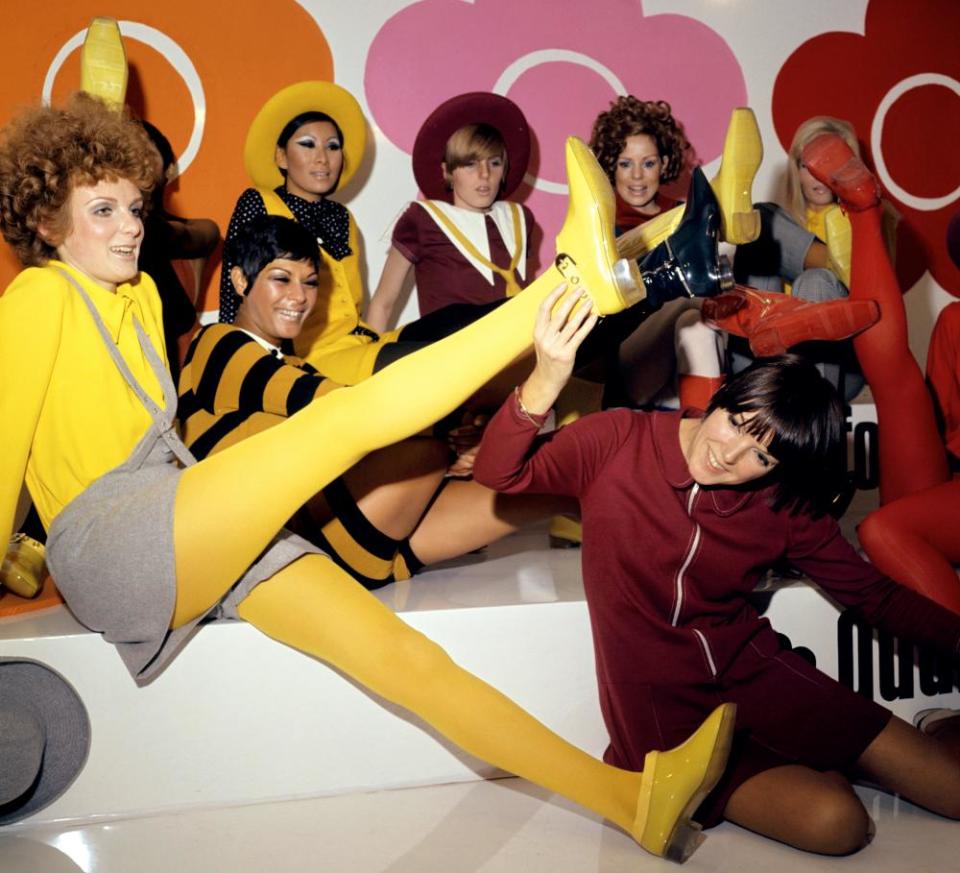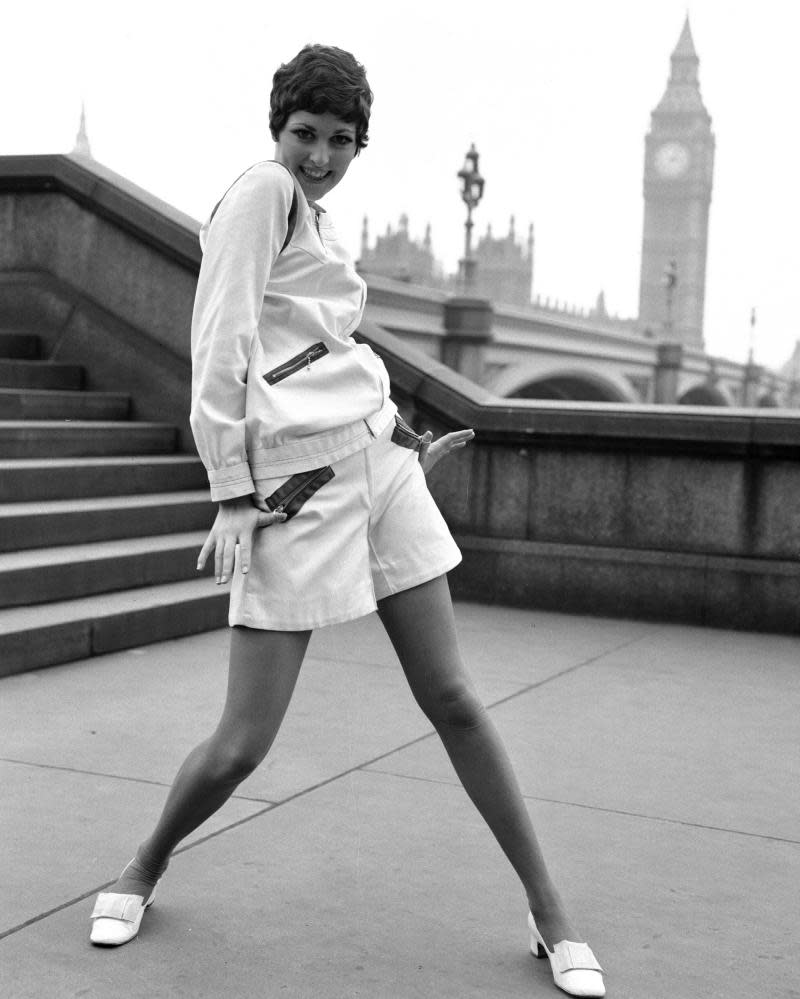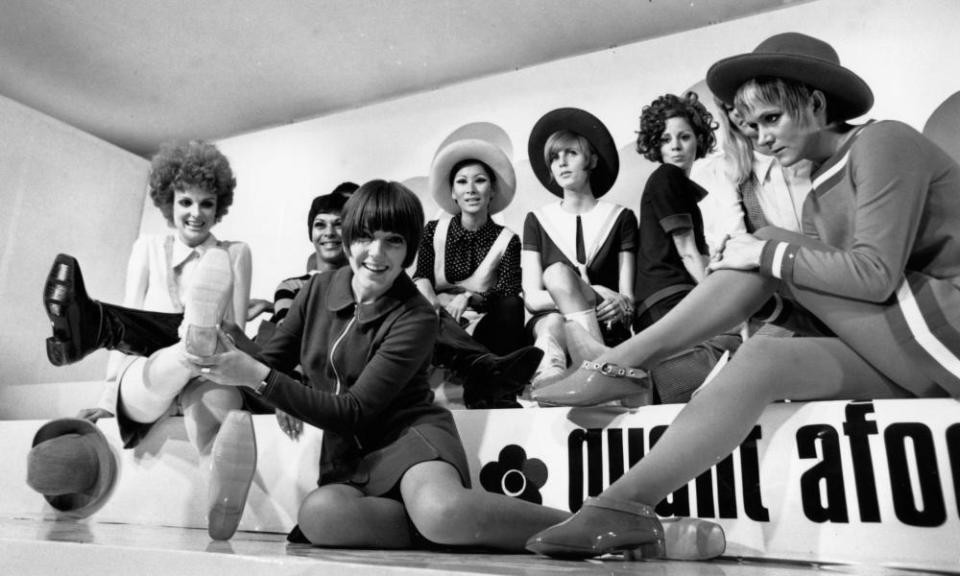Miniskirt mayhem! Nine ways Mary Quant revolutionised women’s clothes – and lives
Before Mary Quant, it was almost impossible to run upstairs in a skirt or shed a discreet tear while wearing mascara. The 60s fashion designer, who gave mass-market appeal to thigh-skimming miniskirts and pioneered clothes for working women, is the subject of a feature-length film that opens in cinemas this week. Quant, directed by Sadie Frost, tracks the designer’s career, from opening her boutique in Chelsea to running the world’s first global superbrand. While contemporary designers give us trends, Quant reset the dial on the way we get dressed. Under her influence, women rejected their parents’ vision of beauty and embraced their own. Her legacy continues today – here are nine ways she changed how women dress.
The miniskirt
It is serendipitous that this retrospective of Quant’s lasting impact as a designer coincides with a major moment for the miniskirt. Or perhaps it’s a sign that life is about to get considerably better. Quant, who is often credited with inventing the miniskirt (and is said to have named the style after her beloved Mini Cooper car), felt that high hemlines represented “life and tremendous opportunity”. She brought with her “a party atmosphere”, notes Jenny Lister, curator of textiles and fashion at the Victoria and Albert Museum: “It was a renaissance. A time when young people could meet different people, listen to different music, a time when they could be themselves.” At the recent catwalk shows in Paris, this idea of the thigh-skimming garment as a symbol of optimism and youthful rebellion seemed to inspire designers again, from Dior’s Maria Grazia Chiuri to Alaïa’s Pieter Mulier. “I like very much the ideas of the younger generation right now,” noted Chiuri, ahead of her recent show. “The miniskirt represents that spirit.”
The original workwear
“Clothes are a statement about what one wants to be,” said Quant. For her customers, the first generation to have access to the contraceptive pill and the opportunity to plan a career and a family, liberation topped the agenda. As her godson, Jasper Conran, points out in Frost’s documentary, “The young working girl set the pace.” It’s here that contemporary workwear – the versatile, dynamic approach to dressing we take for granted – was born. “She was the first to make clothes you could run for the bus in,” says retail expert Jane Shepherdson. “Quant gave us fashion with flexibility. Her clothes were to enable women to get up and go wherever they wanted.”
Saying no to stockings

It wasn’t until Quant got her hands on hosiery that tights – instead of stockings – found mass-market appeal. “Quant didn’t invent tights, but she made everyone aware of them,” says Lister. Keen to find a companion for her signature skirts and dresses, they became Quant’s secret weapon, and remain the most underappreciated of her ideas. Partnering with the Nylon Hosiery Company, Quant created tights to complement her jewel-coloured collections. This season, with party tights back on the agenda – McQueen’s are dripping in diamanté while the German company Falke is unveiling tights in primary colours – it’s impossible to ignore their enduring appeal.
Pockets with everything
The next time you slip your phone into your dress pocket or dig your hands into the sides of your jumpsuit when you feel awkward at a party (Victoria Beckham is an expert at this), send Quant a mental note of thanks. She once declared, “The pockets make the dress” and undoubtedly understood the value of this hidden detail long before much of the rest of the fashion industry. In her quest to dress women desperate to escape their mothers’ style, the pocket emerged as an emblem of modernity, as well as the perfect place to stash a lipstick and the bus fare home.
The ‘boyfriend’ fit

Gender-fluid clothing is regularly billed as the future of fashion, but Quant was ahead of her time. Finding the cut of men’s knitwear to be more closely aligned with the relaxed and casual aesthetic she wished to create, the designer bought men’s suiting from Harrods and repurposed it for women. She also worked with Scottish knitwear suppliers to develop the loose, easy cricket sweaters that have come to define her brand. The look lives on today with sloppy, masculine fits an emblem of cool for contemporary knitwear designers. It has significant appeal on the resale market, too, with Gen Z consumers on Depop snapping up cricket knits repurposed as sweater dresses. Quant would be proud.
Athleisure 1.0

Our obsession with clothes designed to be worn on the sofa as well as to work out peaked during the pandemic. Without Quant, the fashion phenomenon known as athleisure might never have occurred. Jersey was her Lycra, and she was the first designer to give her seal of approval to a fabric on the basis that it was comfortable and, crucially, didn’t crease. Having discovered the concept of “house wear” during a trip to the US, she took the idea that clothes could be both cool and comfortable a step further with a line of adult-sized babygrows, launched in the late 60s. Somewhere between a tracksuit and a dressing gown, this was the original adult onesie.
The skinny-rib sweater
This autumn, the rollneck sweater is being championed by everyone from Adele to Prince William. But the skinny-rib first became a style staple in the hands of Quant. In her 1966 biography, she describes the moment she tried on an eight-year-old boy’s top and was thrilled with the results. For Quant, the fine-knit, ribbed sweater served as the perfect pairing with her signature pinafore and became the foundation of a look that was emulated across the globe.
Party flats

For Quant’s women, a generation who worked all day and danced all night, flat shoes were a logical accessory. Previously, flats had been a dowdy, utilitarian option, but under Quant they became associated with glamour. “Everyone wearing trainers now is the same line of progress,” says Lister. “Quant was reaching for comfortable, practical shoes that looked good as a means to extend her look. In doing so, she allowed women to tread a new path.”
Fun-proof mascara
“Now that the clothes are different, the face was wrong,” noted Quant in 1968, realising that women needed the right makeup to go with the look. Her pioneering cosmetics line soon followed, with a waterproof mascara, unheard of at the time, central to its success. Not only could women run for the bus in one of her skirts and do a day’s work on their feet in her shoes, but they could also shed a tear in her mascara and still look good. “With everything she did, Quant got rid of the idea that women should behave in a certain way. Instead, she made space for people to be themselves,” says Lister.
• Quant is released nationwide on 29 October

